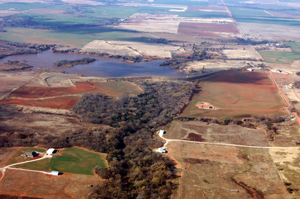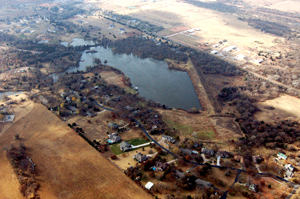The True Cost of Unrestrained Development

Cottonwood Creek Sites 15 & 54
The upstream flood control dam Cottonwood Creek Site No. 15 in Kingfisher County, known locally as Simmons Lake, is scheduled to be decommissioned. That means the dam will be removed and water will no longer be impounded. The landscape will be shaped, graded and re-planted to return to as close to original condition as possible. The irony is that there is nothing wrong with the dam or the lake. It is in good condition, well maintained and functioning just as it should.

Local landowners, there will miss the lake, but understand the reasons behind this action. When the dam was built in 1967, the location was rural and in the unlikely event that it happened to breach, no loss of life was likely. Therefore, it was built to low hazard dam specifications. In the intervening years, development downstream and placement of homes in the breach inundation area has required, by state law, that the dam be reclassified as a high hazard dam. Modification of the dam is now required to minimize the risk of dam failure.
In a typical rehab design, the principal spillway tower and outlet pipe through the dam might be replaced and the height and depth of the dam increased to hold more water of a longer period frequency flood event than the original design. An average cost for rehabilitation as stated is estimated at about $1 million per dam in Oklahoma.
Due to a new housing development in close proximity to the auxiliary spillway, rehab design for Cottonwood 15 requires a complex concrete spillway running up the cost estimate to over $9 million. An analysis of the benefits to cost ratio, considering the cost of property and structures protected compared to the construction cost, does not justify rebuilding the dam. The most cost-effective plan to help protect human life is to remove the dam.
There are more than 2,100 upstream flood control dams in Oklahoma, many of them reaching the end of their design life expectancy. Of those, 229 are classified as high-hazard. The USDA Natural Resources Conservation Service has a program to rehabilitate the dams provided federal funding is available and that state matching funds are available as well. Funds are limited from both sources.
“We can’t rehabilitate the dams as fast as developers can build homes and business downstream,” said Mike Thralls, executive director of the Oklahoma Conservation Commission. “The result is a situation where new homes and businesses are unnecessarily placed in harm’s way because of unrestrained development,” he said.
A “sister” dam to Cottonwood 15 is Cottonwood Creek Site No. 54, about 15 miles to the east in Logan County. Also originally built as a low-hazard rural dam, Cottonwood 54 is in a similarly problematic situation but with its own unique ramifications. There, also, development downstream gives the dam a high hazard classification requiring modification. But in this case, homes are built around the water’s edge, some with boat docks in the water. Inhabited buildings in that close proximity preclude raising the height of the dam, according to Chris Stoner, NRCS state conservation engineer. Instead, the rehab design calls for the permanent pool level to be lowered 4.3 feet by lowering the opening at which water will start to enter the principal spillway tower and run out the pipe to flow downstream. That will provide the needed flood storage to meet current dam safety criteria. The sponsors anticipate that this plan will not be popular with the landowners around the lake, but it is the best and most cost-efficient compromise the designers have come up with to protect the landowners around the lake and downstream and still meet dam safety requirements.
Of the 229 high hazard dams in the state, 88 of them were either originally designed as high hazard, have already been assessed or rehabilitated or are in the rehabilitation process. In 2010 the Oklahoma Legislature passed House Bill 1884 directing the Conservation Commission, with help from the USDA Natural Resources Conservation Service and local conservation districts, to perform assessments on the remaining 141 high hazard dams and to map the breach inundation areas. That effort is underway and is expected to be completed in September 2011. To perform that assessment on the remainder of the flood control dams in the state would require approximately $14 million in funding according to OCC and NRCS estimates.
“One goal of identifying all the breach inundation areas of the state’s flood control dams would be to support action at the state Legislature that would prevent developers from building homes or business in those areas,” Thralls said. “Or possibly to pay a fee for a permit to build in those areas, with the funds, hopefully, used to offset the cost of dam rehabilitation,” Thralls said.
